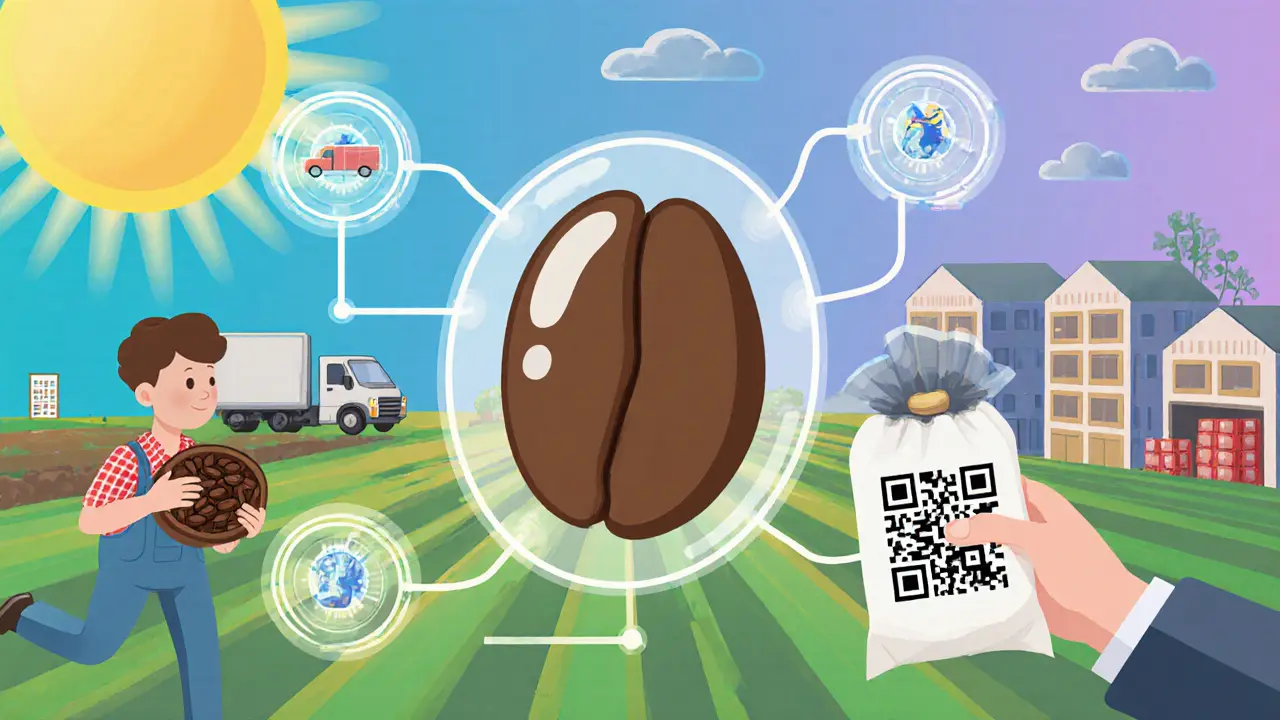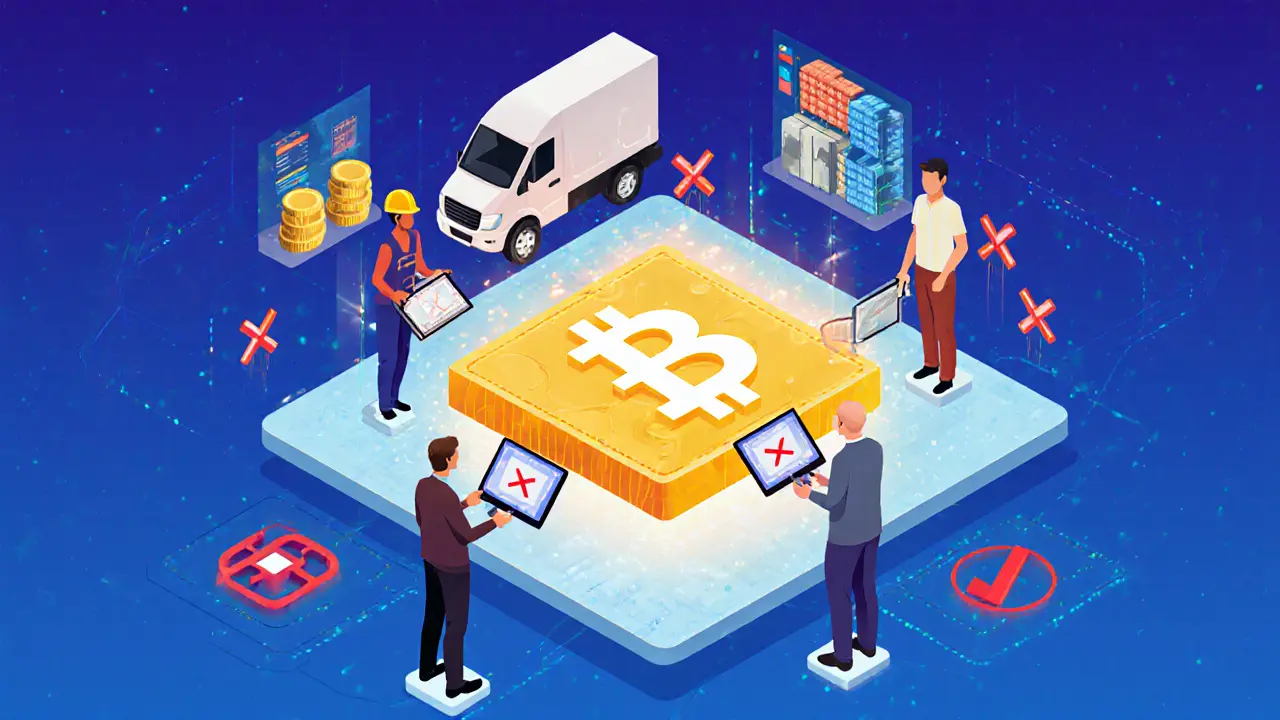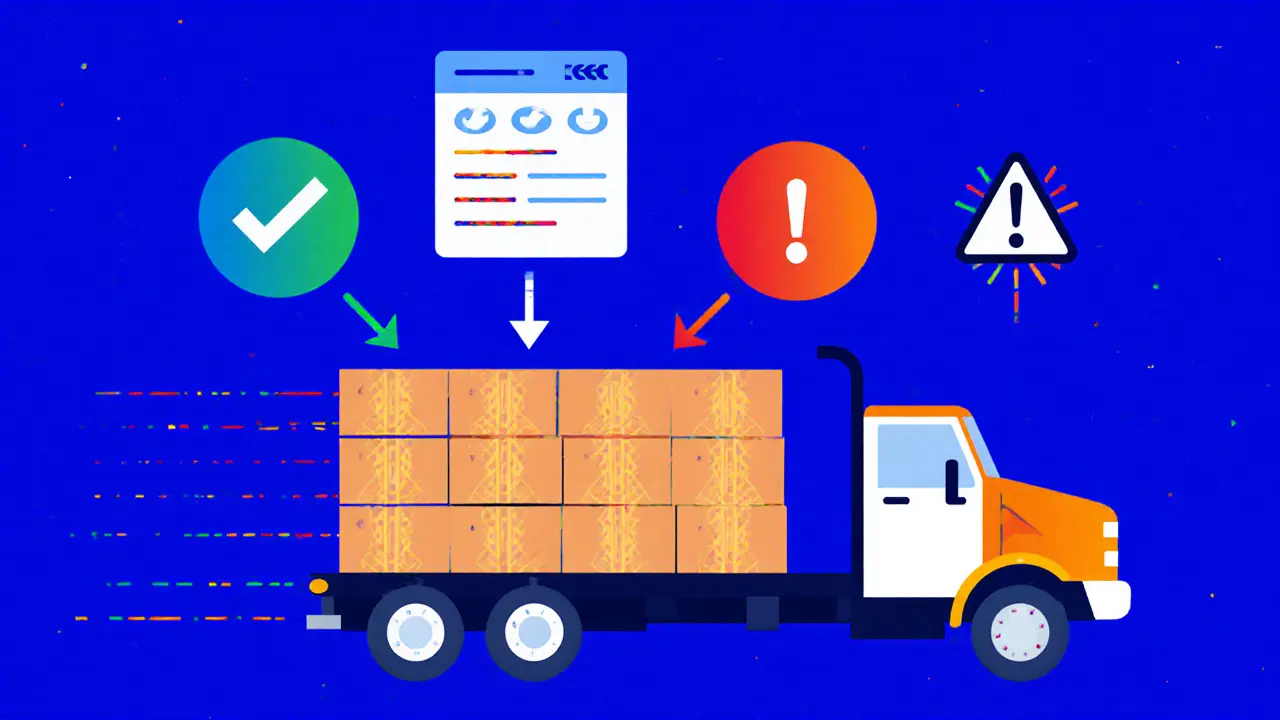Blockchain for Supply Chain Transparency: How It Works and Why It Matters
 Jan, 26 2025
Jan, 26 2025
Supply Chain Blockchain ROI Estimator
This calculator estimates potential cost savings from implementing blockchain technology based on real-world data from industry studies. Input your current annual costs for fraud, recalls, and audits to see how blockchain could reduce these expenses.
- Supply chain fraud costs by 42%
- Recall expenses by 35%
Based on industry data: 42% reduction in fraud costs, 35% reduction in recall costs.
Note: Audit costs are not reduced by blockchain implementation.
Imagine you buy a bag of coffee labeled "fair trade" and "organic." But how do you really know it’s true? Was the bean picked by someone paid fairly? Did it travel through 12 different warehouses without being mixed with cheaper beans? Traditional supply chains can’t answer that. They rely on paper receipts, spreadsheets, and trust-none of which hold up under scrutiny. That’s where blockchain for supply chain transparency changes everything.
What Blockchain Actually Does in a Supply Chain
Blockchain isn’t just a fancy database. It’s a shared, unchangeable ledger that every participant in a supply chain can see and verify. Think of it like a Google Doc everyone can read but no one can secretly edit. Every time a product moves-from farm to factory to warehouse to store-a new entry is added. That entry includes details like location, temperature, time, and who handled it. Once written, it’s locked in forever. This isn’t theory. In 2023, a major food retailer in the U.S. traced a contaminated spinach batch back to a single farm in under 2 seconds. Under the old system, it took 7 days. That’s the power of blockchain: speed, accuracy, and proof. The magic comes from four core features:- Immutability: Once data is recorded, it can’t be deleted or altered. No backdating invoices or hiding delays.
- Decentralization: No single company owns the system. Suppliers, shippers, customs, and retailers all hold copies. No one can cheat the system alone.
- Real-time visibility: Everyone sees the same data at the same time. No more arguing over who has the latest shipment update.
- Cryptographic security: Each participant has a digital key. Only authorized people can add or view data. No impersonation.
Why Old Systems Fail
Most companies still use ERP systems like SAP or Oracle to track inventory. But those systems are siloed. Your supplier’s data doesn’t talk to your transporter’s system. And if someone makes a mistake-or lies-you have no way to prove it. A 2024 study by Deloitte found that 68% of supply chain disruptions were caused by broken communication between partners. A shipment gets delayed. No one knows why. The retailer blames the shipper. The shipper blames the warehouse. The warehouse blames the weather. No one has proof. Blockchain ends that. Every step is timestamped, signed, and stored. If something goes wrong, you don’t guess-you know. And it’s not just about delays. Think about counterfeit goods. The World Customs Organization estimates $500 billion in fake products move through global supply chains every year. Fake pharmaceuticals, fake electronics, fake luxury goods. With blockchain, each product gets a unique digital fingerprint. Scan the QR code on the box, and you see its entire journey. No fakes can slip through.Smart Contracts: The Automatic Enforcers
Smart contracts are self-executing rules written into the blockchain. They don’t need humans to approve them. They just run when conditions are met. For example: A pharmaceutical company ships vaccines. The smart contract says: "If the temperature stays between 2°C and 8°C during transit, release payment to the carrier. If not, hold payment and alert the quality team." No manual checks. No emails. No delays. If the冷链 breaks, the system knows immediately. The company gets notified. The carrier is held accountable. And the patient gets safe medicine. This isn’t sci-fi. Companies like Maersk and Walmart are using smart contracts to automate payments, compliance checks, and customs clearance. One pilot reduced documentation processing time from 10 days to 1 hour.
Real-World Success Stories
Renault didn’t just test blockchain-they built a network for the entire auto industry. Now, every part from every supplier is tracked on a shared ledger. If a faulty airbag is found, they don’t recall 500,000 cars. They recall the 12,000 that used that specific batch of sensors. Savings? Millions. Time? Reduced from weeks to hours. In the seafood industry, IBM partnered with a group of fisheries to track tuna from the ocean to your sushi plate. Consumers scan a code and see the boat’s GPS coordinates, the catch date, the fishing license number, and even the captain’s name. Before blockchain, 30% of "tuna" sold was actually cheaper fish. Now? That’s down to 2%. Even small businesses are using it. A coffee roaster in Portland now uses blockchain to prove every bean was grown by a cooperative paid 40% above market rate. Their customers pay 15% more-but they know exactly where their money went.The Hard Truth: It’s Not Easy
Blockchain isn’t a magic button. It’s a project. A big one. First, you need buy-in from everyone in the chain. If your biggest supplier refuses to join, the system breaks. You can’t force them. You have to convince them. That takes time. Second, data quality matters. If someone enters "100 units" instead of "100 kg," the whole chain is wrong. Blockchain doesn’t fix bad data-it just makes it permanent. Third, there’s no universal standard. One company uses Hyperledger. Another uses Ethereum. They don’t talk to each other. That’s why groups like GS1 are working on global standards for supply chain data. But until those are adopted, integration is messy. And cost? A full rollout can run $500,000 to $2 million for mid-sized companies. That includes software, training, integration with existing ERP systems, and ongoing maintenance. Small businesses often partner with industry consortia to share the cost.
Who’s Leading the Way?
You don’t have to build this from scratch. Big tech companies offer ready-made platforms:- IBM Blockchain: Used by Walmart, Nestlé, and FedEx. Strong in food and pharma.
- Microsoft Azure Blockchain: Good for companies already using Microsoft tools. Integrates with Dynamics 365.
- Oracle Blockchain: Built for enterprises with complex ERP needs. Strong in manufacturing.
- Surgere: A niche player focused on sustainable supply chains and ESG reporting.
What’s Next?
The future of supply chain transparency isn’t just blockchain. It’s blockchain + IoT + AI. Imagine sensors on pallets that automatically log temperature, humidity, and shock levels. That data feeds directly into the blockchain. Then AI analyzes it: "This shipment had 3 temperature spikes. Risk of spoilage: 87%." That’s already happening in cold chain logistics. In 2025, 40% of pharmaceutical shipments using blockchain also use IoT sensors. The result? 92% fewer spoilage claims. And regulators are catching up. The EU’s new Digital Product Passport law requires electronics and clothing to carry digital records of materials, origin, and recycling info. Blockchain is the only practical way to deliver that at scale.Is It Right for You?
Ask yourself:- Do you deal with high-value, regulated, or easily counterfeited goods?
- Do you get blamed for problems you didn’t cause because records are missing?
- Do customers ask where your products come from-and can you prove it?
- Are you losing money to delays, recalls, or fraud?
Can blockchain prevent all supply chain fraud?
No. Blockchain prevents digital tampering, but not physical fraud. If someone swaps a real product for a fake one before it’s scanned, the blockchain will still record the fake as real. That’s why blockchain works best with physical verification-like QR codes, RFID tags, or tamper-proof seals. It’s a digital layer on top of real-world controls, not a replacement.
Do I need to be a tech expert to use blockchain for my supply chain?
No. You don’t need to write code. Platforms like IBM Blockchain and Oracle offer user-friendly dashboards where supply chain managers can track shipments, approve documents, and set alerts without touching a line of code. The tech team handles the backend. Your job is to define what data matters and who gets access.
How long does it take to implement blockchain in a supply chain?
A pilot project can be up and running in 3-6 months. Full company-wide rollout usually takes 12-18 months. The biggest delays aren’t technical-they’re organizational. Getting suppliers, logistics partners, and internal teams aligned takes time. Start with one product line and one key partner to test the waters.
Is blockchain more expensive than traditional tracking systems?
Upfront, yes. But long-term, often no. Traditional systems cost money too-through recalls, lost shipments, audits, and legal fees from fraud. A 2025 McKinsey study found companies using blockchain reduced supply chain fraud costs by 42% and recall expenses by 35% within two years. The ROI isn’t in saving on software-it’s in avoiding disasters.
Can small businesses use blockchain, or is it only for big companies?
Yes, small businesses can use it-often through industry networks. Instead of building their own blockchain, a small coffee roaster can join a consortium like the Blockchain Food Alliance. They pay a low monthly fee to access the network and share data with their buyers. You don’t need to be IBM to benefit. You just need to be part of a group that is.
Lisa Hubbard
November 22, 2025 AT 21:59Look, I get it, blockchain sounds cool, but let’s be real-most of these supply chain stories are just marketing fluff wrapped in tech jargon. I’ve seen companies spend millions on ‘transparent’ systems only to have the same old delays, same old mislabeled boxes, same old silence when something goes wrong. The data’s on the chain, sure, but who’s actually checking it? The guy at the warehouse? The guy at the store? Nah. They’re scanning barcodes like always. The blockchain’s just a fancy digital trophy on the shelf. I mean, I believe in transparency, but not if it means more paperwork, more meetings, and more excuses from people who think ‘immutable ledger’ fixes human laziness.
And don’t get me started on the cost. $500K to track coffee beans? That’s not innovation. That’s a luxury tax on ethical consumers. If I’m paying 15% more for coffee, I want to know the farmer’s name, not the hash of the block it was recorded on.
Also, who’s maintaining this thing? Who’s fixing it when the sensor on the pallet dies? Who’s retraining everyone every time a new ‘standard’ drops? It’s not magic. It’s just another system that needs humans to work-and humans are messy. I’ll stick with my local co-op that lets me visit the farm. At least I can see the dirt on their boots.
And yes, I know this is long. I’m tired of being sold snake oil as salvation.
Belle Bormann
November 23, 2025 AT 21:26im not a techie but i tried the qr code on my coffee bag and it showed me the farm, the picker, and even the truck that brought it. no lie, it made me cry. i had no idea my $12 bag had that much story behind it. blockchain is not perfect but it makes truth real. i trust it more than a label now. simple as that.
ps: i spelled a few words wrong. sorry. but the truth is right.
Jody Veitch
November 25, 2025 AT 20:29It’s refreshing to see Americans finally adopting a technology that actually matters-unlike the crypto gambling nonsense that flooded our feeds for years. This isn’t some Silicon Valley fantasy. This is precision engineering applied to a broken global system. The EU’s Digital Product Passport? That’s the future. And anyone who claims blockchain is ‘too expensive’ is just clinging to the outdated, inefficient, and frankly irresponsible practices of the 20th century. We are not debating whether to adopt this-we are debating how fast we can phase out the analog chaos. If you’re still using spreadsheets to track pharmaceuticals, you’re not a business owner-you’re a liability.
And no, I don’t care if it’s ‘hard to implement.’ If you can’t manage a supply chain without fraud, you don’t deserve to operate at scale. Period.